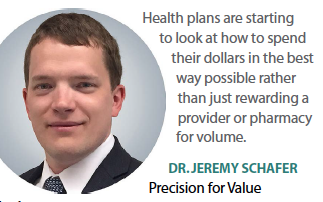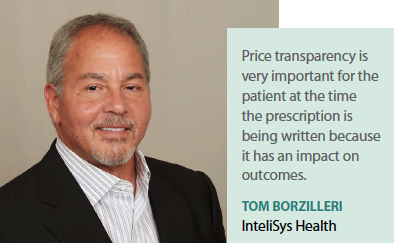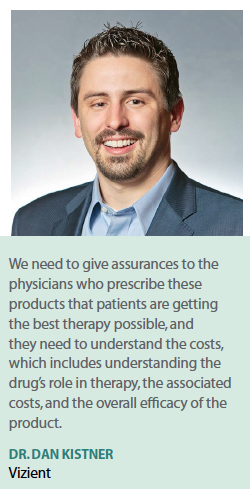Pharmaceutical pricing is a complex — and often controversial — issue impacting all stakeholders in healthcare. Discussions around value, fair pricing, transparency, outcomes, and patient affordability are front and center as companies try to provide some insight, but each stakeholder in this group of cohorts has very different needs.
 There is no easy way to address the challenges for each stakeholder while ensuring a system to bring innovation to the market.
There is no easy way to address the challenges for each stakeholder while ensuring a system to bring innovation to the market.
Payers, including insurance companies, PBMs, and government payers, have been pushing back on high costs and are increasing copays and coinsurance premiums for patients. Policymakers are taking notice, with drug pricing being a big topic of the 2016 election.
Growth in spending on medicines for 2016 slowed to less than half the rate seen in 2014 and 2015, according to a May 2017 report from The IMS Institute (now IQVIA Institute for Human Data Science). The rate of growth, however, remained above inflation.
And while almost 90% of all drugs on the market are generic medicines, they accounted for 26% of the costs in 2016, according to IQVIA. More than 50% of positive spending growth in 2016 was from new brands that have been available for fewer than 24 months.
Express Scripts, one of the largest PBMs, expects overall drug spending to increase 10% to 13% between 2017 and 2019. For inflammatory conditions, the PBM expects around 30% year over year  through 2019, reflecting expected increases in both cost and utilization. The forecast diabetes trend of 20% reflects continued cost and utilization trend for insulins, as well as increased utilization of DPP-4 and SGLT2 inhibitors, which are prescribed as additive therapy for controlling blood sugar.
through 2019, reflecting expected increases in both cost and utilization. The forecast diabetes trend of 20% reflects continued cost and utilization trend for insulins, as well as increased utilization of DPP-4 and SGLT2 inhibitors, which are prescribed as additive therapy for controlling blood sugar.
In oncology, Express Scripts predicts medications by patients as maintenance therapy will result in increased utilization of expensive medications, and a forecast of 20% trend through 2019.
Experts predict approvals over the next few years will continue the trend of first-in-class, specialty medications and medications for rare diseases. The late-phase pipeline holds 2,346 novel products, and 40 to 45 new active substances are expected to be launched on average for each of the next five years.
Oncology remains the area of greatest activity. Many of these drugs will feature new mechanisms of action and likely will launch with prices reflecting this.
For these reasons, drug pricing will likely continue to draw intense focus as stakeholders balance access and costs.
“The pressure is going to continue because drug prices continue to have a lot of visibility," says Jeremy Schafer, Pharm.D., senior VP of payer access solutions at Precision for Value. “When individuals, who aren’t used to paying a lot for healthcare, see these prices, it boggles their mind. They don’t have a full understanding of where the price comes from. Many of the discounts and price  reductions that are applied to drugs are under contract so there is little to no transparency in terms of the pricing."
reductions that are applied to drugs are under contract so there is little to no transparency in terms of the pricing."
Our health system faces a unique challenge: the innovation of precision medicines and therapies for previously untreatable diseases has rapidly outpaced the models we use to pay for them, says Leslie Isenegger, principal strategist, Syneos Health’s Reputation & Risk Management Practice.
“While the national dialogue has focused on drug costs, the real question healthcare stakeholders and policymakers need to ask is ‘how can we innovate our reimbursement system to accommodate increasingly personalized therapies?’"
Some pharma companies have worked with payers to develop risk-sharing agreements and outcomes-driven contracts, and Ms. Isenegger expects this trend to grow with the introduction of more gene-based therapies.
“The real question is: how do we make these value-based contracts more attractive and less onerous to enter into and execute?" she asks.
This pressure on pricing is already having an impact on price increases. The increase in the list price of prescription drugs was historically between 13% and 15%, but these are now in the 8% range, says Karla Anderson, partner at PwC.
Many point out, however, that list pricing is not the actual cost paid.
Bob Easton, co-chairman of Bionest, says the public and the governing bodies don’t understand the unique aspects of pricing in the drug industry.
“Prescription drugs are a target that’s easy for people to pick on without really understanding the context," he says. “The fundamental problem in the industry is that the originator gets between five and 12 years to recover the development costs for the value of its innovation."
He points to Gilead’s hepatitis C therapies as an example. When Sovaldi — the first non-interferon therapy for hepatitis — received FDA approval in 2013, it was priced at $1,000 per pill, making the total cost of the treatment $84,000.
“This drug saves the healthcare system $100,000 but 10 years from now Gilead won’t get paid for it," Mr. Easton says. “Some generic company will get paid $3,000. Innovator companies only have a limited time frame to get paid for the value that they bring to society and the medical community."
The Value Debate
Value has become healthcare’s hottest topic, but the system has yet to build consensus on how to define and measure it — an issue that only gets more complicated for rare diseases with limited, if  any, treatment options. Experts agree that aligning value and price is a positive, but determining value is complicated and open to debate.
any, treatment options. Experts agree that aligning value and price is a positive, but determining value is complicated and open to debate.
Organizations such as the Institute for Clinical and Economic Review (ICER) and Innovation and Value Initiative and the National Pharmaceutical Council are trying to find common ground on measuring value.
ICER, for instance, performs analyses on effectiveness and costs. The organization has posted reports on abuse deterrent opioids, PARP inhibitors for ovarian cancer, and non-drug treatments for chronic low back and neck pain.
ICER has also worked with companies to evaluate value of new therapies. For example, Sanofi and Regeneron Pharmaceuticals worked with the organization to assess value and with payers to negotiate pricing of Dupixent, approved in March 2017 to treat severe to moderate atopic dermatitis, a serious form of eczema. While lower than competitors Humira and Enbrel, the list price of Dupixent is $37,000 a year. ICER’s evaluation found that Dupixent’s expected net price is aligned with the added benefit it provides to patients and represents good value for the money.
Another organization, the Innovation and Value Initiative (IVI), in November launched the IVI Open-Source Value Project, a tool to better measure value in healthcare treatments. The effort kicks off with the release of an open-source tool focused on measuring value in treatments for rheumatoid arthritis. IVI will regularly update the RA model based on comments and recommendations provided by stakeholders.
Dr. Schafer says the healthcare system in the United States is evolving from one that was volume-based to one that is value-based.
“We are starting to see an evolution around providing value and health plans looking at how to spend their dollars in the best way possible rather than just rewarding a provider or pharmacy for doing volume," he says.
He says a discussion of value needs to involve clinical output along with the discussion of price.
 “Payers are looking cost-effectiveness," he says. “They are looking at what they are getting for their money. For some diseases, this is easier to determine than for others. For example, when Novartis released the heart failure drug Entresto, the company made a deal with payers that reimbursements or rebates may differ depending on whether or not patients had to be hospitalized because their condition got worse."
“Payers are looking cost-effectiveness," he says. “They are looking at what they are getting for their money. For some diseases, this is easier to determine than for others. For example, when Novartis released the heart failure drug Entresto, the company made a deal with payers that reimbursements or rebates may differ depending on whether or not patients had to be hospitalized because their condition got worse."
He says this discussion of value will become even more important when it comes to precision medicines and those for rare diseases.
“In the precision medicine area where drugs are tailored to very specific biomarkers and genetic factors, the population for those drugs starts to decrease," Dr. Schafer says.
Dr. Schafer says this is because there is little competition in the rare disease space, so so health plans and pharmacy benefit managers have reduced leverage to negotiate for lower prices.
Purchasing groups are looking for companies to be creative, says Daniel Kistner, Pharm.D., senior VP, pharmacy solutions, Vizient, a group purchasing organization for hospitals and integrated delivery systems.
“Inside the four walls of a hospital, we need to give assurances to the physicians who prescribe these products that they are getting the best therapy possible, and they need to understand the costs as well," he says.
Dr. Kistner says Vizient and its members are looking for transparent pricing models where they can validate the data.
“We don’t want to stand in the way of innovation, but we should be able to have some insight and some justification on why a product might cost hundreds of thousands of dollars," he says. “We want to do what’s best for the patient. Transparency about why a therapy might have a really high price tag would really go a long way."
Industry experts say it’s important for pharma companies to tell a value story to payers, providing data about the product’s outcomes and clinical benefit, including quality of life. This, in addition to clinical trial data, will provide a payer with a more complete story.
But value is a subjective term, says Arthur Caplan, Ph.D., a professor of bioethics at New York University’s Langone Medical Center and founding director of NYULMC’s division of medical ethics.
“Value is part of the picture, but it is not enough," he says.
Payers’ efforts looking at outcomes-based reimbursement helps, but it is just a Band-Aid for high costs, Dr. Caplan says. “We need a more systematic emphasis; we want our research to not only produce the next generation of drugs but also we want to produce affordable drugs," he says.
Value is often in the eye of the beholder, Ms. Isenegger says, adding that it is no surprise that patients and treaters define value differently from a payer perspective.
One critical issue in value measurement of medicines is figuring out how to move beyond drug pricing alone to start assessing the overall health system impacts — and socio-economic benefits — of innovative therapies that minimize health complications, reduce hospitalizations, and improve patients’ independence and productivity.
“To do this, value frameworks should include perspectives from patients, their caregivers, and the physicians who treat them," Ms. Isenegger says.
She points out that ICER bases its value assessments on a cost per quality adjusted life year (QALY) thresholds, but is working to address contextual considerations of value beyond clinical and cost-effectiveness. Another group, the Innovation and Value Initiative, is engaging healthcare stakeholders in debate and consensus-building around value using an open-source approach often seen in software development.
The Patient Affordability Issue
Roughly half of Americans take prescription medications. Patients’ out-of-pocket costs are generally controlled through co-pays. Fixed copays and co-insurance have been relatively stable in plan designs, according to IQVIA. But more patients now have drug benefit deductibles and more plans have added separate cost tiers with higher copays or use of coinsurance for specialty drugs. This means more patients have greater exposure to higher costs.
A study by IQVIA found that average patient out-of-pocket costs declined in 2016 as more patients received zero out-of-pocket cost prescriptions or paid lower costs or used generics, and a declining share paid rising costs. But an increasing number of patients are facing high costs and are reaching maximum out-of-pocket costs during the year.
“At least part of patients’ concerns about prescription drug prices is related to what they feel in their paycheck regarding the larger, rising costs of healthcare insurance and care," says Paul Tyahla, senior strategist, Syneos Health’s Reputation & Risk Management Practice. “Discussing value in terms that resonate with patients is the best way to put price into context. It can reveal the ways in which the clinical or lifestyle needs of patients are met, the long-term savings to the healthcare system, and the continued investment in understanding a particular disease."
But an IQVIA report predicts that as more new specialty products become available, more patients will use them and face increased prices as part of their cost-sharing.
A 2016 Pharmacy Benefit Management Institute report found that managing the specialty drug cost trend continues to be a goal in employer-sponsored plans. In fact, 38% of employers have a pharmacy deductible, up from 36% the year before, and 38% have formularies or co-insurance with four or more tiers, up from 26% in 2012. Of those employers that indicated they were considering changes, the most frequent responses were adding more tiers (47%), which can sometimes double the out-of-pocket costs patients see.
High out-of-pocket costs do impact patient behavior. Many patients are abandoning prescriptions at the pharmacy due to sticker shock, and abandonment rates for brands are 2.5 times higher when a patient faces a deductible and sees the full cost of the medicine compared with patients who had a set copayment, according to IQVIA.
“If companies can cure patients but patients can’t afford their medication, then no one has cured anything," Dr. Kistner says.
Dr. Schafer points out that multiple studies show that when there is a per-prescription cost in excess of $150 to $200 a month, patient adherence drops.
The Kaiser Family Foundation December 2016 survey found that 14% of insured people under the age of 65 cut pills in half or did not fill a prescription. For those making less then $40,000 a year, 25% cut pills in half or skipped doses and 30% didn’t fill a prescription. Of those polled by the Kaiser Family Foundation in September 2016, 77% say the cost of prescription drugs is unreasonable.
The pharmaceutical industry is trying to address patient affordability under the Partnership for Prescription Assistance, which brings together manufacturers to help low income or uninsured patients get access to medications.
For those facing high co-insurance and co-pays, many manufacturers offer co-pay assistance programs. These program help a great many people, but Dr. Schafer says patients in government programs such as Medicare aren’t eligible for these programs.
“Additionally, some health plans and pharmacy benefit managers are now introducing new programs that limit the ability of patients to use those programs. Assistance programs are not a long-term solution to the affordability issue," he says.
Making this even more complicated is that patients with deductibles and coinsurance for prescription medicines pay cost-sharing that is based on the undiscounted list price of a medicine, rather than the discounted price negotiated by their health plan or PBM, finds a report by PhRMA and Amundsen Consulting. In the commercial market, one in five prescriptions for brand medicines are filled in the deductible or with coinsurance, and cost-sharing for these prescriptions accounts for more than half of patients’ total out-of-pocket spending on brand medicines.
Between 2012 and 2016 alone, the share of commercial health plans requiring patients to meet a deductible for prescription medicines increased from 23% to 49%.
According to the PhRMA/Amundsen Consulting report, rebates paid by biopharmaceutical companies can reduce the list prices of brand medicines. For certain medicines used to treat diabetes, asthma, high cholesterol, and hepatitis C rebates can reduce list prices by as much as 30% to 55%.
Pharma companies are working to address access and affordability of medicines in a number of ways. First, they are working with payers to secure coverage for innovative medicines to ensure that patients who need these therapies can get them — and that physicians are not overly burdened by administrative protocols when prescribing the treatments they think are best for their patients, Ms. Isenegger says.
“Some drug makers are sharing risk with payers, creating outcomes-based reimbursement models like the one Novartis is creating with CMS for its groundbreaking CAR-T drug Kymriah," she says.
As patient cost exposure has increased year over year, manufacturers have increased their out-of-pocket offsets through coupons and other savings programs, offsetting cost such that final patient out-of-pocket remains fairly stable, according to IQVIA.
Co-pay assistance is good for the patient, but not for insurance companies, says Tom Borzilleri, CEO of InteliSys Health. This has a direct effect on patient outcomes.
“Co-pay assistance forces the insurance company to have to pay for a more expensive drug instead of the generic or lower-cost alternative," he says.
He points to Harvoni as an example. “The cost of Harvoni to an insurance company for a 12-week therapy cycle is between $84,000 and $86,000," he says. “The patient may only pay $100 a week after the co-pay assistance. But another therapy, Mavyret, is an alternative that is clinically and therapeutically equivalent to Harvoni. Mavyret’s cost for a 12-week period is $13,000, which makes it more affordable for the insurance company."(PV)
~~~~~~~~~~~~~~~~~~~~~~~~~
Estimates on 2018 Prices
Vizient estimates that for pharmaceutical purchases made from Jan. 1, 2018, to Dec. 31, 2018, health systems can expect a 7.61% increase in price. The forecast is focused on pharmaceutical use in both hospital and non-acute settings. Vizient bases inflation estimates for the forecast period on past price change history during the last 36 months where available, as well as current knowledge of contract allowances and marketplace factors such as expiring patents and anticipated new competition.
The Vizient report also found that the world’s 10 most expensive drugs are all orphan drugs. Therapies for extremely limited populations continue to be introduced at ever-higher prices, which limit access to the very patient groups these treatments are intended. In addition, certain suppliers appear to be engaging in practices such as repurposing mass-market drugs as orphan drugs, disease slicing, repurposing old compounds, and off-label use.

















